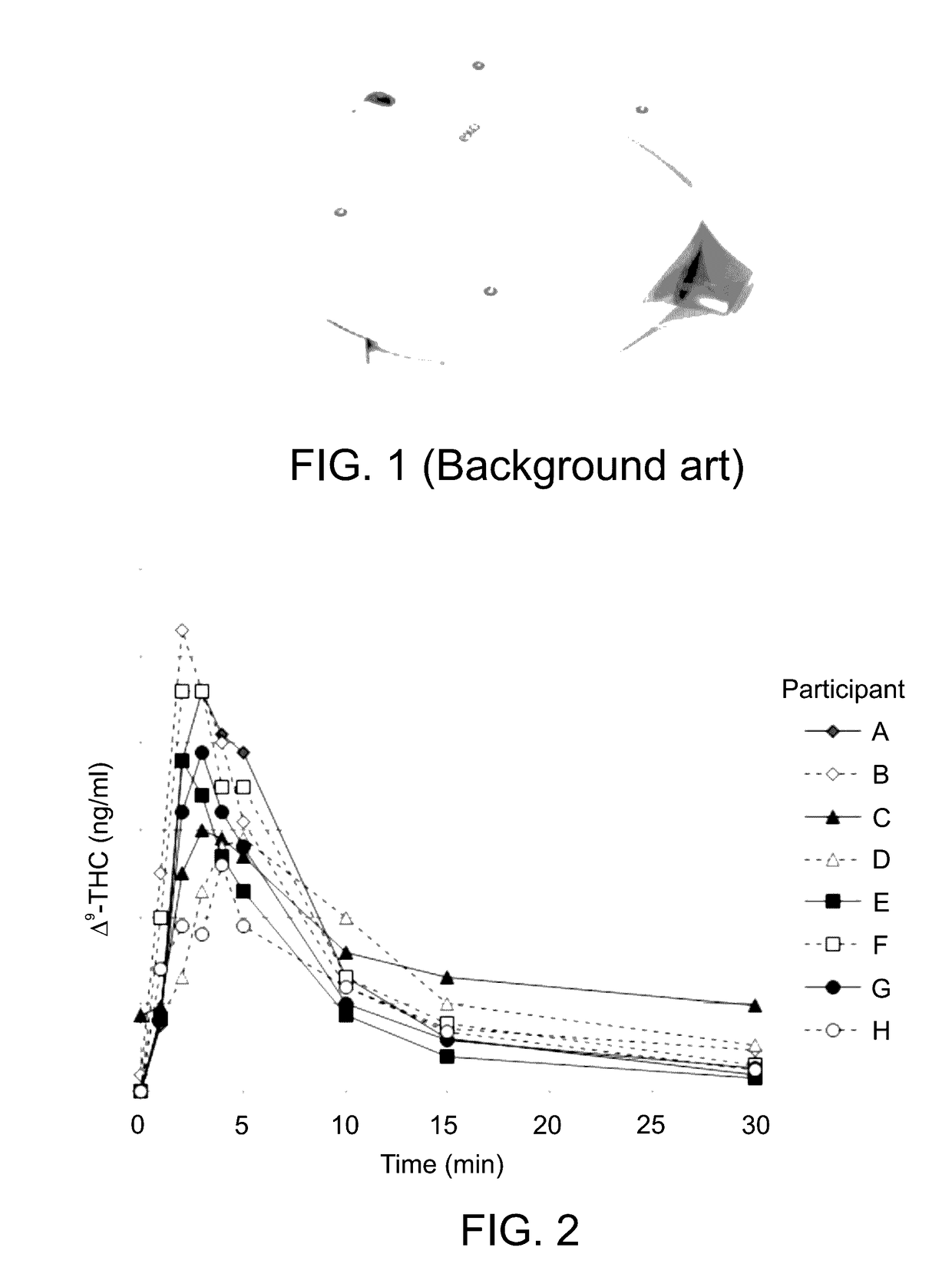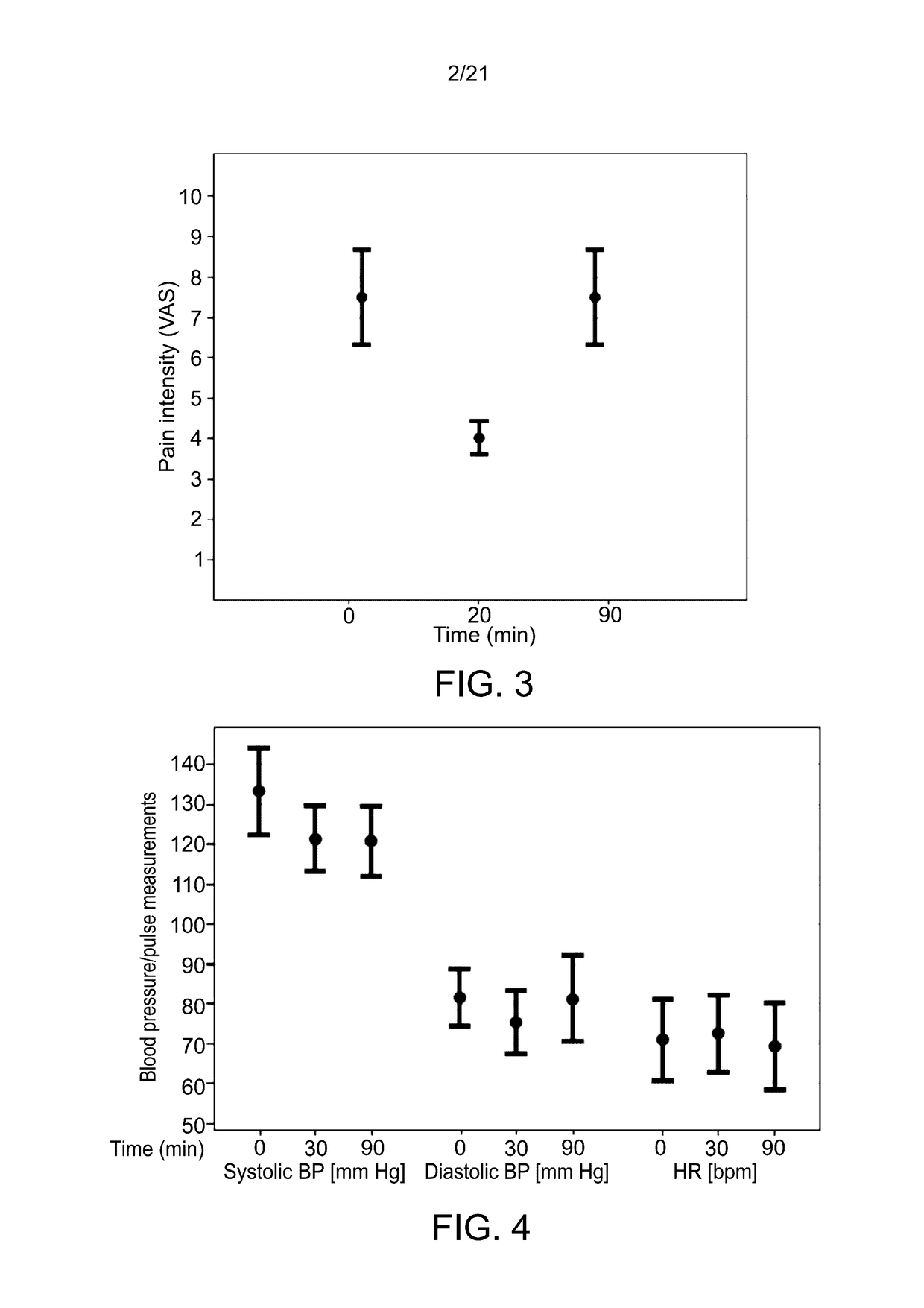Methods, devices and systems for pulmonary delivery of active agents
- Summary
- Abstract
- Description
- Claims
- Application Information
AI Technical Summary
Benefits of technology
Problems solved by technology
Method used
Image
Examples
example 1
Pharmacokinetic Studies
[0682]A study was conducted in order to characterize the inter-individual variability of Δ9-THC plasma levels during the absorption phase, upon using a hand-held metered-dose MDI device configured for pulmonary delivering pre-determined amounts of the active agent Δ9-THC from a solid substance (cannabis-derived plant substance) upon heating the substance.
[0683]The study was used to further evaluate the pharmacodynamic effect of pulmonary delivery of Δ9-THC on pain reduction from baseline using a 10 cm visual analog scale (VAS) pain scale (0 being no pain; and 10 being worst possible pain); for monitoring adverse effects, blood pressure and heart rate, and for estimating the degree of satisfaction with the use of the MDI on a 0-10 scale.
[0684]Study Cohort:
[0685]The study was conducted at the Pain Research Unit of Rambam Health Care Campus in Haifa, Israel. Cohort patients were enrolled in the study after meeting the following criteria:[0686](a) Aged 18 years or...
example 2
Comparative Analyses
[0717]The data obtained in the studies described in Example 1 were analyzed comparatively to smoking, oromucosal, oral and intravenous administration of Δ9-THC and inhalation using the commercially available Volcano® vaporizer.
[0718]Plasma Cmax Levels Per Mg of Δ9-THC Administration:
[0719]The present inventors have compared THC yields obtained via pulmonary delivery according to the method described herein to data published in the art (Background art), the comparative results being graphically presented in FIG. 6.
[0720]Thus, intravenous administration of Δ9-THC, as a reference mode of delivery, yielded the highest plasma Cmax levels per mg of Δ9-THC administered—43.8 (as reported by Ohlsson, et al. Clin Pharmacol Ther. 1980; 28(3):409-16; the column denoted “Ohlsson (3)” in FIG. 6), and 32.8, 23.8 ng Δ9-THC / ml plasma (as reported by D'Souza et al., Neuropsychopharmacology, 2004; 29(8):1558-72; the column denoted “D'Souza (14)” in FIG. 6).
[0721]Among the alternati...
example 3
Therapeutic Window Determining and PD-Profile Personalization
[0729]In accordance with the personalized pulmonary delivery method described herein, a dose and a regimen was calculated to maintain the treatment within a pre-determined therapeutic window for an individual patient, referred to herein as “Patient X”, for 3 hours, using an algorithm specifically developed for a metered-dose inhaler device used according to some embodiments of the present disclosure. The therapeutic window calculations were based on THC concentration in the plasma and body (PK profile of THC) as known in the art, combined with the PK variables of Patient X (e.g., BMI, age, gender etc.), as described hereinabove.
[0730]A dosing (a plurality of pre-determined vaporized amounts) and a regimen (time intervals between doses) were determined for Patient X by an algorithm that simulates a pharmacokinetic profile of that patient based on the above-presented and other PK studies conducted in a population of subjects...
PUM
| Property | Measurement | Unit |
|---|---|---|
| Mass | aaaaa | aaaaa |
| Mass | aaaaa | aaaaa |
| Mass | aaaaa | aaaaa |
Abstract
Description
Claims
Application Information
 Login to View More
Login to View More - R&D
- Intellectual Property
- Life Sciences
- Materials
- Tech Scout
- Unparalleled Data Quality
- Higher Quality Content
- 60% Fewer Hallucinations
Browse by: Latest US Patents, China's latest patents, Technical Efficacy Thesaurus, Application Domain, Technology Topic, Popular Technical Reports.
© 2025 PatSnap. All rights reserved.Legal|Privacy policy|Modern Slavery Act Transparency Statement|Sitemap|About US| Contact US: help@patsnap.com



